

Balanced news, issues and opinions, media bias ratings, political news. Balanced news via media bias ratings for an unbiased news perspective. Navigating Digital Information. Civic Online Reasoning. *DigiPo4 Moves Infographic. Video course: Fundamental search for journalists (Datajournalism.com) Global Media Manipulation Case Book. MediaWise: How to sort fact from fiction online. Civic Online Reasoning Classroom Poster. Students Should Know - Media Literacy Clearinghouse. SUMMA News Literacy Curriculum for Schools and Universities - Ad Fontes Media. That’s why we believe in the power of learning content analysis.

Through the practice of analyzing and rating genuine, contemporary articles, students hone the skills necessary to discern veracity, identify perspective, and recognize spin. Our approach makes learning news literacy fun and engaging. Through the 10-lesson course, students first learn our content analysis methodology. Then, by rating news articles themselves, students apply their learning as they create their own Media Bias Charts, individually or collectively. The more articles and news sources they rate, the more complete their charts will be–and the more skilled they will be at critically analyzing the news. The curriculum includes our 10-lesson news analysis training, the current static Media Bias Chart and updates for the length of the subscription, and access to CART❐ – our Content Analysis Rating Tool.
Digital Diligence - Medialogues (November 2021) - Google Docs. News Literacy Project: Resources Archive. Webinars and Online Learning. AllSides for Schools. 24 Cognitive Biases stuffing up your thinking. Thou shalt not commit logical fallacies. First Draft Observation Challenge. Quiz: How well can you tell factual from opinion statements? Which Face Is Real? Choose Your Own Fake News. Bad News. Verif!cation Quiz Bot (@quiztime) / Twitter. Harmony Square. DeepFakes, Can You Spot Them? Fakey. Interactive Media Bias Chart – 2 – Ad Fontes Media. *Check, Please! Starter Course: Caulfield. Curriculum_Materials. Local news in peril — News Literacy Project. A baseless conspiracy theory about the COVID-19 pandemic migrated from fringe internet communities into more mainstream conversations last week, spreading dangerous doubt about the seriousness of the pandemic in cities across the United States and around the world.
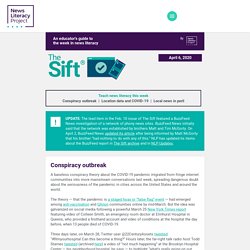
*SIFT (The Four Moves) How can students get better at sorting truth from fiction from everything in between?
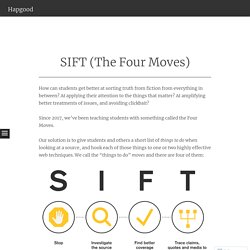
At applying their attention to the things that matter? At amplifying better treatments of issues, and avoiding clickbait? Since 2017, we’ve been teaching students with something called the Four Moves. Our solution is to give students and others a short list of things to do when looking at a source, and hook each of those things to one or two highly effective web techniques. We call the “things to do” moves and there are four of them: Stop The first move is the simplest. First, when you first hit a page or post and start to read it — STOP.
Second, after you begin to use the other moves it can be easy to go down a rabbit hole, going off on tangents only distantly related to your original task. Please keep in mind that both sorts of investigations are equally useful. Investigate the source We’ll go into this move more on the next page. Find better coverage. Sifting Through the Pandemic – Information hygiene for the Covid-19 infodemic. *Civic Online Reasoning. If young people are not prepared to critically evaluate the information that bombards them online, they are apt to be duped by false claims and misleading arguments. To help teachers address these critical skills, we’ve developed assessments of civic online reasoning—the ability to judge the credibility of digital information about social and political issues. These assessments ask students to reason about online content.
We’ve designed paper-and-pencil tasks as well as tasks that students complete online. These assessments are intended for flexible classroom use. Informable Digital. URI Media Lab: Teaching Resources (Renee Hobbs) Mind Over Media: Analyzing Contemporary Propaganda (URI) This web platform provides an opportunity to explore the subject of contemporary propaganda by hosting thousands of examples of 21st century propaganda from around the world. Users can upload, examine and discuss examples of propaganda from our own daily lives. By examining propaganda, rating its potential impact, and commenting on it, people share their interpretations with others. Learn to Discern: Media Literacy Trainer's Manual. People are flooded with misinformation, disinformation, manipulative content, and junk information that drown out credible information.
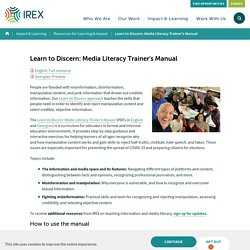
Our Learn to Discern approach teaches the skills that people need in order to identify and reject manipulative content and select credible, objective information. The Learn to Discern: Media Literacy Trainer’s Manual (PDFs in English and Georgian) is a curriculum for educators in formal and informal education environments. It provides step-by-step guidance and interactive exercises for helping learners of all ages recognize why and how manipulative content works and gain skills to reject half-truths, clickbait, hate speech, and fakes. These issues are especially important for preventing the spread of COVID-19 and preparing citizens for elections. Topics include: Connected Society: media literacy discussion cards. Digital Forensics Resources Master List: Verification Handbook. The latest edition of the Verification Handbook arrives at a critical moment.
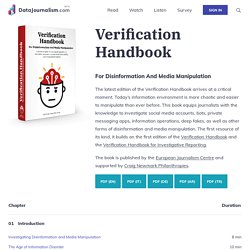
Today’s information environment is more chaotic and easier to manipulate than ever before. This book equips journalists with the knowledge to investigate social media accounts, bots, private messaging apps, information operations, deep fakes, as well as other forms of disinformation and media manipulation. The first resource of its kind, it builds on the first edition of the Verification Handbook and the Verification Handbook for Investigative Reporting. DataJournalism.com. Project Look Sharp. *The News Literacy Project. Fauxtography Archives - Snopes.com. NEWS LITERACY FOR VIRTUAL PROTESTERS by Elaine Levia. Curriculum_Materials. News Quality Chart. Politicalcartoons.com - Cartoons. What's Going On in This Graph? What’s Going On in This Picture?
What is MediaWise? - Poynter. MediaWise is a groundbreaking digital literacy project that engages with teenagers both online and in school.
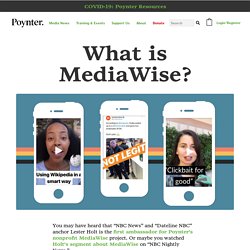
The mission of the project is to teach 1 million teenagers — half from underserved communities — how to sort fact from fiction on the internet by 2020. Will you help us spread facts, not falsehoods? Support MediaWise today. While teens are generally regarded as digitally savvy, research from our partners at Stanford History Education Group (SHEG) shows that the vast majority of teenagers have trouble navigating digital information — whether it’s viral hoaxes on Instagram, misinformation campaigns on Facebook, or sponsored content on news websites.
MediaWise addresses these issues with new curriculum to be deployed in fall 2019, in-person events at schools nationwide and fact-checking content and outreach via social media. >>Contact mwtips@poynter.org to bring MediaWise to your school. News & Media Literacy. Media Literacy Clearinghouse. Fake News Historical Timeline (Common Sense Education) Beyond Fake News. Society of Professional Journalists Code of Ethics. Junk News Aggregator. Facebook Ad Library. Verification Handbook: homepage. Truth Decay. YALSA Teen Literacies Toolkit. Download the print version (PDF) or view the web version.

Created by the Literacies Toolkit Resource Retreat Participants August 2017 About the Kit In this toolkit, we use the “fake news” phenomenon as an approach to addressing multiple literacies. SEEING ISN’T BELIEVING The Fact Checker’s guide to manipulated video (Washington Post) An index of unreliable news websites. The lists we combined to create the index had 1,043 unique domain names.

Of these, as of November 2018, 515 were still active and another 528 were inactive (51 percent) — either no longer online or no longer posting stories. We detected inactive sites programmatically by retrieving HTTP status codes (404s or 301s), using auto-generated screenshots and, in some cases, by visual inspection. We curated the resulting list, trimming it a bit, by removing several sites whose stories, though highly politicized, were mostly not fake: alternet.org, cato.org, heritage.org, nationalreview.com, thedailybeast.com, theintercept.com, thinkprogress.org, and weeklystandard.com. Persuasive Maps.
Fight The Fake: Get the what-why-and-how resource list. Today’s students must learn to filter through the excess of information to find the facts, which is often easier said than done.
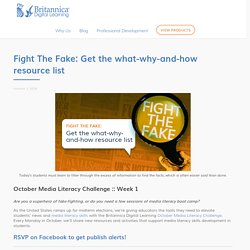
October Media Literacy Challenge :: Week 1 Are you a superhero of fake-fighting, or do you need a few sessions of media literacy boot camp? As the United States ramps up for midterm elections, we’re giving educators the tools they need to elevate students’ news and media literacy skills with the Britannica Digital Learning October Media Literacy Challenge. EdCan Network Facts on Education Fake News 1. First Draft News: Education. Information Disorder: The Definitional Toolbox. Over the past eighteen months, issues of trust and truth in the digital age have dominated discussion across industries and around the world.
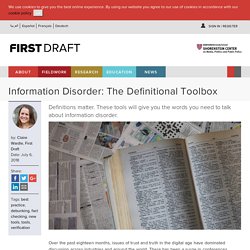
There has been a surge in conferences, reports and funding. However, despite this peak in interest in the subject, progress has been slow. One important realization yet to emerge is that shared definitions and terminology matter. For the policy-makers, technology companies, politicians, journalists, librarians, educators, academics and civil society organizations all wrestling with the challenges caused by false and misleading information, agreeing upon a shared vocabulary is essential. In an effort to help kickstart a conversation about definitions, I co-authored a report last fall that used the umbrella term ‘information disorder’ to describe mis-, dis- and malinformation.
Google News Lab. Facing Facts: An Inside Look At Facebook's Fight Against Misinformation. News Lit Quiz — News Literacy Project. Rate My Sources uwgreenbay.qualtrics. Lead Stories. Fake Collections - The Veronica Butcher Fake Sources Collection - Gould Guides at Carleton College. Five Editor-Approved Tips for Media Literacy in Any Class. In 2015, a year before murmurs of “fake news” became omnipresent, textbook publisher McGraw-Hill was under fire for a World Geography book illustration. The section, on patterns of immigration throughout American history, referred to a wave of “immigration” in which African “workers” arrived in the United States.
Parents, students and teachers were outraged by the sugarcoated and outright false history of slavery being shared in classrooms across Texas. This was one incident of false information making its way into schools, but it was far from the first or last. Clickbait headlines and polarizing politics have made it a daunting challenge for teachers to find factual, reliable information inside and outside of the classroom.
A class needs to share a foundation of truth. Fact-checking and looking for bias are no longer just skills needed in journalism class or at the school paper. Top 10 sites to help students check their facts. A Field Guide to “Fake News” and Other Information Disorders. News Use Across Social Media Platforms 2017. As of August 2017, two-thirds (67%) of Americans report that they get at least some of their news on social media – with two-in-ten doing so often, according to a new survey from Pew Research Center. This is a modest increase since early 2016, when (during the height of the presidential primaries) 62% of U.S. adults reported getting news from social media.
While a small increase overall, this growth is driven by more substantial increases among Americans who are older, less educated, and nonwhite. This study is based on a survey conducted August 8-21, 2017, with 4,971 U.S. adults who are members of Pew Research Center’s nationally representative American Trends Panel. Fake News: How A Partying Macedonian Teen Earns Thousands Publishing Lies. Is This Story Share-Worthy? Flowchart. GRADE LEVEL: Middle and high school TIME: Less than 30 minutes MATERIALS: Is This Story Share-Worthy? Flowchart, either printed on large paper or displayed digitally (download); Is This Story Share-Worthy? Worksheet (download); selections from Teacher Resource – Examples for Evaluating Online News (download); internet access Review the Is This Story Share-Worthy? How to Spot Fake News - FactCheck.org.
The Problem with Fake News (and how our students can solve it) Red Bank Public Library: Fake News Rsources. Nowadays, finding information on an almost limitless number of issues is as easy as opening a browser on your computer or phone, typing the question you want answered on the subject about which you want to learn, and waiting a second or two for a list of links to be displayed.
At this point it is up to the individual to determine which of the links contain accurate, verifiable information, and which contain misleading or outright false information. Some of these determinations are easy. However, it is not unusual for purveyors of false information to cleverly disguise their intentions and deceptive content. Although it has always been a wise practice for consumers of news to approach the task with a degree of skepticism, the increase in the number of media outlets has made it necessary to find ways of determining the validity of the information obtained from the source. That is, consumers must develop media literacy. Fake News, Alternative Facts and Librarians As Dedicated Defenders of Truth. The Cardigan Papers – American history and news literacy meet in the school library,
The Sift. How false news can spread - Noah Tavlin. Not all scientific studies are created equal - David H. "A popular study from the 1970s that helps sell millions of dollars' worth of fish oil supplements worldwide is deeply flawed, according to a new study being published in the Canadian Journal of Cardiology. The original study, by Danish physicians H.O. Bang and D.J. Fake News - LibGuides at William Paterson University. FOG Analysis. CML E-Commerce Web Site - Curricula, Lessons, Activities, Assessment. How To Spot Fake News. 7 Questions Every Student Should Ask. News Literacy - High School. Web Literacy - Mozilla Learning. Help Students Spot Student Fake News. Web Literacy for Student Fact-Checkers. Evaluating news sources is one of the more contentious issues out there. A Rough Guide to Spotting Bad Science.